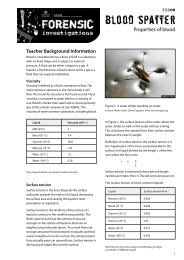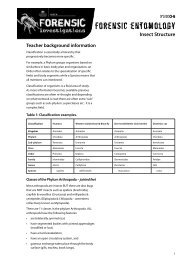blood spatter
blood spatter
blood spatter
- No tags were found...
You also want an ePaper? Increase the reach of your titles
YUMPU automatically turns print PDFs into web optimized ePapers that Google loves.
FSB01blo o d spatte rProgram overviewUsing the laws of physicsto explain <strong>blood</strong>stainsin forensic evidence.Blood <strong>spatter</strong>: suggested lesson plan.The program is designed to enable students toparticipate in a range of activities that require themto make observations, collect, analyse and interpretdata and try to form a conclusion.A scenario is included that drives the programhowever the program is flexible so it can be used inways that suit you and your classroom.You may choose to introduce the online “crimescene” at the start of the program or you mayleave the crime scene as a culminating activity.The suggested activity sequence is with the onlinecrime scene at the conclusion of the program.It would be difficult to recreate the crime scenein your own classroom however certain sectionscould be created with care. The online crime scenewas recreated specifically for a WA Police Forensicstraining program using porcine (pig) <strong>blood</strong>.The program is organised into a series of pdf files.• Background information for the teacher aboutvarious aspects of the program has been included.• Teacher activity information has been providedfor each activity with hints and technical notes.• One PowerPoint presentation hasbeen included for download.• Computer-based resources include a crimescene and three statements about the crime: asuspect, a witness and a victim. Students usetheir knowledge gained from the program todecide what statement fits the evidence.• Student worksheets are divided between aPersonal Dossier and a Crime Dossier. Bothdocuments can be printed to form two separatebooklets that students work from, or you maychoose to print and use only specific activities.Session 1 – What is <strong>blood</strong>?Why is it useful to solve crimes.• FSB03, FSB04, FSB05• Set the scene by showing some footage froma movie or episode of CSI where someoneis injured resulting in <strong>blood</strong> <strong>spatter</strong>.• Use this to generate discussion on the useof <strong>blood</strong> to help solve crime. What do theyalready know about <strong>blood</strong> <strong>spatter</strong>?• Brainstorm ideas on what they already knowabout <strong>blood</strong> and its physical properties.Discussion of surface tension and why this is one ofthe most important properties of <strong>blood</strong> that allowforensics investigators to use <strong>blood</strong> <strong>spatter</strong> to solvecrime.Session 2 – About <strong>blood</strong> <strong>spatter</strong>• FSB10• Talk about the <strong>blood</strong> <strong>spatter</strong> footageshown yesterday. Let the students discussamongst themselves what they saw.• Show the footage again and pauseit on the <strong>blood</strong> <strong>spatter</strong>.• Ask the students to discuss what they could findout from the <strong>blood</strong> <strong>spatter</strong> pattern to help workout how the crime was done. Share the ideaswith the class and record them on the board.• Show PowerPoint presentation (FSB10) ofdifferent types of <strong>blood</strong> <strong>spatter</strong> (passive,transfer, projected, dripped, spilled, projected,arterial spurt, cast off, impact <strong>spatter</strong>.• Ask the students to discuss howeach type is created.• Brainstorm other things that might cause thesize and shape of a <strong>blood</strong> <strong>spatter</strong> to change.• Create some hypotheses.Conduct an experiment to find out how the angleof impact affects <strong>blood</strong> droplet patterns.
FSB01blo o d spatte rProgram overviewSession 3 – The relationship betweenheight and <strong>blood</strong>stain diameter• Activity 1: FSB06, FSB07, FSB08• Conduct an experiment to find out howdrop size and shape changes with height.Session 4 – Influence of surface texture• Activity 3: FSB06, FSB07, FSB08• Conduct an experiment to find out howthe type of surface changes the sizeand appearance of a <strong>blood</strong>stains.• (Compare surfaces such as glass, lino,carpet, wood, concrete and grass.)Session 5 - Determining the directionof travel from a <strong>blood</strong> droplet patternActivity 4: FSB06, FSB07, FSB08• Conduct an experiment to find out how youcan determine the direction a <strong>blood</strong> dropletcame from. and therefore the angle of impact.Session 9 – Determining the area of origin• Activity 7: FSB06, FSB07, FSB08• Students receive a pattern of <strong>blood</strong>stainsthat has been created by a different group ofstudents. Using skills and techniques developedthroughout the program they attempt todetermine the area of origin of the <strong>blood</strong>stains.Session 10 – Scenario• Activity 8: FSB07, FSB09, FSB11• Given a scenario and using the knowledgethey have gained over the last few lessonsstudents try to reconstruct a crime sceneusing <strong>blood</strong> splatter (need to keep recordsof each experiment piece togetherSession 11 – What happened?• Sharing reconstructions and re-enactingwhat they think happened.• Students present their evidence.Session 6 – How does the angle ofimpact affect <strong>blood</strong> droplets?• Activity 2: FSB06, FSB07, FSB08• Conduct an experiment to find out how theangle of impact affects <strong>blood</strong> droplet patterns.Session 7 – Calculate the angle of impact• Activity 5: FSB06, FSB07, FSB08• Use the results from Activity 4 to calculate theangle of impact of various <strong>blood</strong> droplets.Session 8 – The effect ofvelocity on <strong>blood</strong>stains• Activity 6: FSB06, FSB07, FSB08• Do a demonstration or conduct an experimentto assess the effect that changing the amountof force has on the resulting <strong>blood</strong>stains.
FSB01blo o d spatte rMODULE OVERVIEW Using the laws of physics to explain <strong>blood</strong>stains in forensic evidence.ScienceOutcomesLesson Outline & Activities Assessment ResourcesIntroduction and setting the scene.What is forensic science?How is <strong>blood</strong> used as evidence.Physical properties of <strong>blood</strong>.FSB03 What is forensic scienceFSB03 Suggested episodes CSIFSB04 About <strong>blood</strong>FSB05 Properties of <strong>blood</strong>About <strong>blood</strong> <strong>spatter</strong>Discussions of previous CSI footage.PowerPoint presentation.FSB03 Suggested episodes CSIFSB10 Blood <strong>spatter</strong> PowerPointActivity 1The relationship between the <strong>blood</strong>staindiameter and dropping height.Investigating scientifically:developing a hypothesis,identification of variables, resultsand conclusion writing.FSB05 Height and <strong>blood</strong>staininformation.FSB07 Height and <strong>blood</strong>stain activity.FSB008 Student DossierActivity 2The effect of different receiving surfaceson <strong>blood</strong>stains.Investigating scientifically:designing own experiment(hypothesis, variables, methods,results and conclusion)FSB05 Surface and <strong>blood</strong>staininformation.FSB07 Surface and <strong>blood</strong>stain activity.FSB08 Student DossierActivity 3Methods used to determine the directionof <strong>blood</strong> droplets.Investigating scientifically:designing own experiment(hypothesis, variables, methods,results and conclusion)FSB05 Direction of <strong>blood</strong>stainsinformation.FSB07 Direction of <strong>blood</strong>stains activity.FSBS08 Student DossierActivity 4The effect of the angle of impact on theappearance of the <strong>blood</strong> <strong>spatter</strong> pattern.Activity 5Calculation of the angle of impactInvestigating scientifically:designing own experiment(hypothesis, variables, methods,results and conclusion)FSB05 Angle of impact information.FSB07 Angle of impact activity.FSB08 Student DossierActivity 6The effect of velocity on <strong>blood</strong>stains.Investigating scientifically:designing own experiment(hypothesis, variables, methods,results and conclusion)Energy and Change: explanationof why droplets change withspeed using the ideas of energyand force.FSB05 Velocity and <strong>blood</strong>stainsinformation.FSB07 Velocity and <strong>blood</strong>stains activity.FSB08 Student DossierActivity 7Determining the origin of the <strong>blood</strong>.Investigating scientifically:designing own experiment(hypothesis, variables, methods,results and conclusion)FSB05 Area of origin calculationsinformationFSB07 Area of origin calculationsactivity.FSB08 Student DossierStudents willproblem solveand apply theirunderstandings tosolving the crime.Activity 8The online scenario of the crime scene.Students will investigate the crime sceneto try and determine “who did it”.This involves reconstructing “whathappened” on the basis of the <strong>blood</strong>stainpattern.Students may need to conduct moreexperiments themselves to determinewhat the <strong>spatter</strong> pattern is saying.Energy and Change: scientificideas used in explanation of howthe crime was committed.FSB07 Scenario information.FSB11 Scenario activity.FSB09 Crime Dossier.Students willcommunicateideas with otherclass members.Activity 9Sharing reconstructions and re-enactingwhat they think happened.Communicating scientifically:sharing results with rest of class inan oral presentation.FSB09 Crime File



![FSP 19 Anthropometry [PDF File, 298.3 KB]](https://img.yumpu.com/51210323/1/184x260/fsp-19-anthropometry-pdf-file-2983-kb.jpg?quality=85)


![FSE 09 Case studies [PDF File, 140.2 KB] - Centre for Learning ...](https://img.yumpu.com/48750159/1/184x260/fse-09-case-studies-pdf-file-1402-kb-centre-for-learning-.jpg?quality=85)
![FSE 03 [PDF File, 125.2 KB] - The University of Western Australia](https://img.yumpu.com/47991868/1/184x260/fse-03-pdf-file-1252-kb-the-university-of-western-australia.jpg?quality=85)
![FSE 01 Overview [PDF File, 163.0 KB]](https://img.yumpu.com/47583056/1/184x260/fse-01-overview-pdf-file-1630-kb.jpg?quality=85)
![FSE 10 Teachers activity [PDF File, 3.0 MB] - Centre for Learning ...](https://img.yumpu.com/45506425/1/184x260/fse-10-teachers-activity-pdf-file-30-mb-centre-for-learning-.jpg?quality=85)
![Chapter 03 [PDF File, 468.5 KB] - Centre for Learning Technology](https://img.yumpu.com/44881443/1/184x260/chapter-03-pdf-file-4685-kb-centre-for-learning-technology.jpg?quality=85)
![Chapter 09 5 [PDF File, 192.4 KB]](https://img.yumpu.com/44599682/1/184x260/chapter-09-5-pdf-file-1924-kb.jpg?quality=85)
![FSB 03 [PDF File, 151.9 KB]](https://img.yumpu.com/43260078/1/184x260/fsb-03-pdf-file-1519-kb.jpg?quality=85)

![FSE 11 Rearing flies [PDF File, 388.4 KB]](https://img.yumpu.com/41885287/1/184x260/fse-11-rearing-flies-pdf-file-3884-kb.jpg?quality=85)
![FSP 26 Crime Dossier [PDF File, 3.2 MB]](https://img.yumpu.com/36466452/1/184x260/fsp-26-crime-dossier-pdf-file-32-mb.jpg?quality=85)
![FSE 07 Forensic entomology [PDF File, 196.9 KB]](https://img.yumpu.com/35416705/1/184x260/fse-07-forensic-entomology-pdf-file-1969-kb.jpg?quality=85)